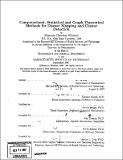Computational, statistical and graph-theoretical methods for disease mapping and cluster detection
Author(s)
Wieland, Shannon Christine
DownloadFull printable version (23.02Mb)
Other Contributors
Harvard University--MIT Division of Health Sciences and Technology.
Advisor
Kenneth Mandl and Bonnie Berger.
Terms of use
Metadata
Show full item recordAbstract
Epidemiology, the study of disease risk factors in populations, emerged between the 16th and 19th centuries in response to terrifying epidemics of infectious diseases such as yellow fever, cholera and bubonic plague. Traditional epidemiological studies have led to modifications in hygiene, diet, and many other practices that have profoundly altered the dynamic between humans and diseases. In this thesis, we develop mathematical techniques to address modern challenges, including emerging diseases such as SARS and West Nile virus, the threat of bioterrorism, and stringent legislation protecting patient privacy. Within spatial epidemiology, one problem is to map the risk of disease across space (i.e., disease mapping), and another is to analyze the data for clustering. We propose a general technique, cartograms created from exact patient location data, that can address both of these problems. We also develop a graph-theoretical method to detect spatial clusters of any shape based on Euclidean minimum spanning trees. For mapping applications, we present an optimal strategy for mapping patient locations that preserves both privacy and spatial patterns within the data. For real-time disease surveillance, in which the goal is early detection of outbreaks based on time-series data, we introduce a generalized additive model that maintains constant specificity on various time scales.
Description
Thesis (Ph. D.)--Harvard-MIT Division of Health Sciences and Technology, 2007. Includes bibliographical references (p. 107-119).
Date issued
2007Department
Harvard University--MIT Division of Health Sciences and TechnologyPublisher
Massachusetts Institute of Technology
Keywords
Harvard University--MIT Division of Health Sciences and Technology.